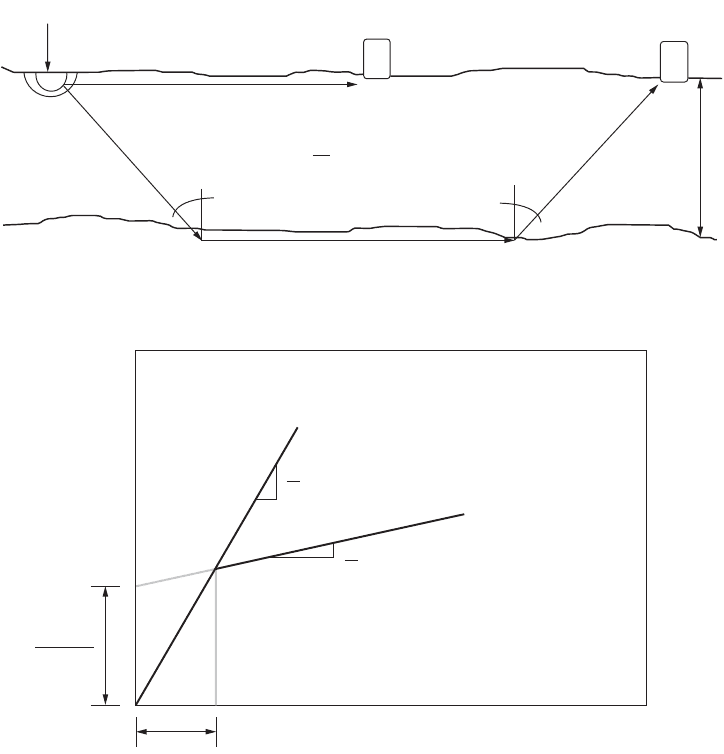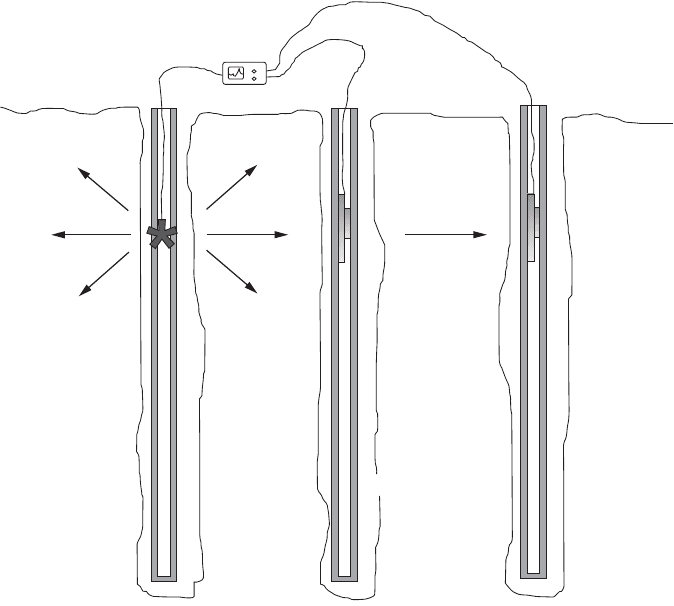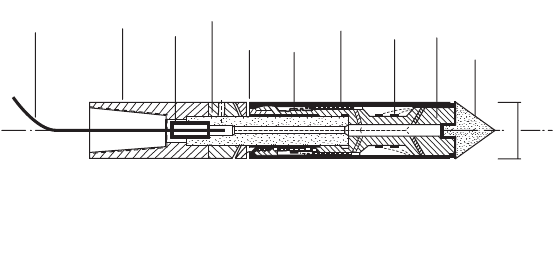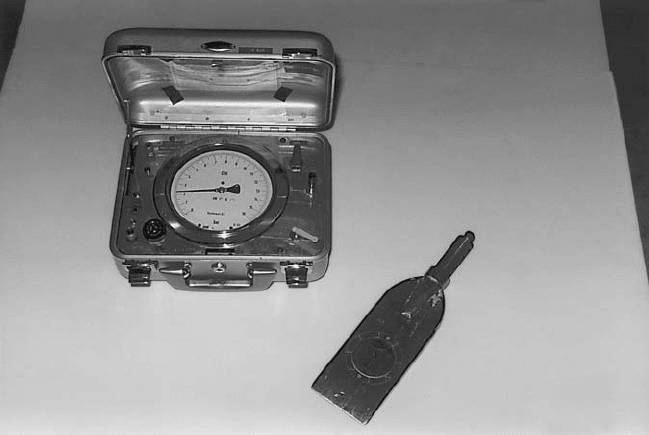Wai-Fah Chen.The Civil Engineering Handbook
Подождите немного. Документ загружается.


27-16 The Civil Engineering Handbook, Second Edition
FIGURE 27.9 Seismic refraction test configuration.
V
1
Source
Receiver
Direct Wave Arrival
sin i
c
=
Receiver
H
i
c
i
c
Refracted Wave Arrival
Time
Refracted Wave
Distance
Direct Wave
V
2
(V
1
< V
2
)
1
V
2
x
c
x
c
= 2H*((V
2
+V
1
)/(V
2
−V
1
))
2
1
V
1
V
1
V
2
2Hcos i
c
V
1
© 2003 by CRC Press LLC

In Situ Subsurface Characterization 27-17
FIGURE 27.10 Crosshole seismic test configuration.
Source
Tr igger
Oscilloscope
Inputs
Receiver
Boreholes
Casing
Grout
© 2003 by CRC Press LLC
27-18 The Civil Engineering Handbook, Second Edition
References
ASTM 1194, Standard Test Method for Bearing Capacity of Soil for Static Load and Spread Footings,
Vol. 04.08.
ASTM D1586, Standard Test Method for Penetration Test and Split Barrel Sampling of Soils, Vol. 04.08.
ASTM D1587, Standard Practice for Thin-Walled Sampling of Soils, Vol. 04.08.
ASTM D2573, Standard Test Method for Field Vane Shear Test in Cohesive Soil, Vol. 04.08.
ASTM D3213, Standard Practices for Handling, Storing and Preparing Soft Undisturbed Marine Soil,
Vol. 04.08.
ASTM D3441, Standard Test Method for Deep, Quasi-Static, Cone and Friction Cone Penetration Tests
of Soil, Vol. 04.08.
ASTM D4220, Standard Practices for Preserving and Transporting Soil Samples, Vol. 04.08.
ASTM D4428, Standard Test Methods for Crosshole Seismic Testing, Vol. 04.08.
ASTM D4719, Standard Test Method for Pressuremeter Testing in Soils, Vol. 04.08.
ASTM D5079, Standard Practice for Preserving and Transporting Rock Samples, Vol. 04.08.
Baguelin, F., Jezequel, J. F., and Shields, D. H.1978. The pressuremeter and foundation engineering. Trans.
Tech., 617 pp.
Becker, D. E., Crooks, J. H. A., and Been, K. 1987. Interpretation of the field vane test in terms of in situ
and yield stresses. In ASTM Symp. Lab. Field Vane Shear Strength Test. Tampa.
Daniel, D. E. 1989. In situ hydraulic conductivity tests for compacted clay. J. Geotech. Eng., ASCE. 115(9):
1205–1226.
de Mello, V. F. B. 1971. The standard penetration test. In Pro. 4th Pan Am Conf. Soil Mech. Found. Eng.,
Puerto Rico. 1:1–86.
Demartinecourt, J. P., and Bauer, G. E. 1983. The modified borehole shear device. Geotech. Test. J., ASTM.
6(1):24–29.
Handy, R. L., and Fox, N. S. 1967. A soil borehole direct shear test device. Highway Res. News 27:42–51.
Handy, R. L., Remmes, B., Moldt, S., Lutenegger, A. J., and Trott, G. 1982. In situ stress determination
by Iowa stepped blade. J. Geotech. Eng., ASCE. 108(GT11):1405–1422.
Harder, L. F., and Seed, H. B. 1986. Determination of Penetration Resistance for Coarse Grained Soils Using
the Becker Hammer Drill, Report No. UCB/EERC-86-06, University of California, Berkeley.
Janbu, N., and Senneset, K. 1973. Field compressometer — Principles and applications. Proc. 8th Int.
Conf. Soil Mech. Found. Eng. Moscow, 1.1:191–198.
Marchetti, S. 1980. In situ tests by flat dilatometer. J. Geotech. Eng., ASCE. 106(GT3):299–321.
Marsland, A. 1971. Large in situ tests to measure the properties of stiff fissured clays. Proc. Aust. — N. Z.
Conf. Geomech., Melbourne, 1:180–189.
Marsland, A. 1972. Clays subjected to in situ plate tests. Ground Eng. 5, 5(6):24–31.
Robertson, P.K., and Campanella, R. G. 1983. Interpretation of cone penetration tests. Part I: Sand, Part
II: Clay. Can. Geotech. J. 20(4):718–745.
Schmertmann, J. H. 1970. Suggested Method for Screwplate Load Test. Am. Soc. Test. Mater., Spec. Tech.
Publ. 479: 81–85.
Schmertmann, J. H. 1986. Suggested method for performing flat dilatometer test. ASTM Geotech. Test.
J., ASTM. 9(2):93–101.
Woods, R. D. 1978. Measurement of dynamic soil properties. Proc. ASCE Spec. Conf. Earthquake Eng.
Soil Dynamics, Pasadena, 1:91–178.
For Further Information
There is a very extensive bibliography describing the numerous test devices and methods introduced in
this chapter. There have been a number of important conferences, symposia, and workshops over the
past two decades. The interested reader is encouraged to review the proceedings of such meetings for
additional information. The principal proceedings include the following:
© 2003 by CRC Press LLC
In Situ Subsurface Characterization 27-19
•Proceedings of ASCE Specialty Conference on In Situ Measurement of Soil Properties, Raleigh,
USA, 1975.
•Proceedings of ASCE Specialty Session on Cone Penetration Testing and Experience, St. Louis,
USA, 1981.
•Proceedings of First European Symposium on Penetration Testing, ESOPT I, Stockholm, Sweden,
1974.
•Proceedings of Second European Symposium on Penetration Testing, ESOPT II, Amsterdam,
Holland, 1982.
•Proceedings of ASCE Specialty Conference on Use of In Situ Tests in Geotechnical Engineering,
(IN SITU ’86), Blacksburg, USA, 1986.
•Proceedings of First International Symposium on Penetration Testing, (ISOPT I), Orlando, USA,
1988.
In addition to the above proceedings, a number of substantive reports have been written by various
researchers/practitioners about specific test devices. Some of the more notable ones include the following:
•Mitchell, J. K., Guzikowski, F., and Villet, W. C. B., The Measurement of Soil Properties In Situ,
Geotechnical Engineering Report # LBL-636, University of California, Berkeley, 1978.
•Robertson, P. K., and Campanella, R. G., Guidelines for Geotechnical Design Using CPT and CPTU,
Soil Mechanics Report # 120, University of British Columbia, 1989.
•Miran, J., and Briaud, J. L., The Cone Penetrometer Test, Geotechnical Report, Texas A&M Uni-
versity, 1990.
•Davidson, J. L., Bloomquist, D. G., and Basnett, C. R., Dilatometer Guidelines and the Effects of
Dynamic Insertion, Report # FL/DOT/MO/345-89, University of Florida, 1988.
•Whittle, A. J., Aubeny, C. P., Rafalovich, A., Ladd, C. C., and Baligh, M. M., Prediction and
Interpretation of In Situ Penetration Tests in Cohesive Soils, Report # R91-01, Massachusetts Institute
of Technology, 1991.
•Schmertmann, J. H., Guidelines for Using the Marchetti DMT for Geotechnical Design, Vo lumes 3
and 4, Report # FHWA-PA-024+84-24 and Report # FHWA-PA-025+84-24, NTIS, 1988.
•Kulhawy, F. H., and Mayne, P.W., Manual on Estimating Soil Properties for Foundation Design,
Report # EPRI EL-6800, Electric Power Research Institute, 1990.
© 2003 by CRC Press LLC

© 2003 by CRC Press LLC
28
In Situ
Testing and
Field Instrumentation
28.1 Introduction
28.2
In Situ
Tests
The Role of
In situ
Testing in a Site Investigation Program •
Standard Penetration Test • Cone Penetration Test •
Pressuremeter Test • Dilatometer Test • Field Vane Test
28.3 Instrumentation for Monitoring Performance
Planning of an Instrumentation Program • Instruments •
Examples of Applications of Field Instrumentation
28.1 Introduction
In all geotechnical engineering problems, performance prediction requires determination of the proper-
ties of the soil or rock mass under consideration, and their appropriate use employing soil mechanics
theories. For the determination of the soil properties to be used in design, geotechnical engineers can
follow two, often complementary, approaches: obtain soil samples from the field and subsequently
perform laboratory tests on these samples, or make use of
in situ
tests
.
Laboratory tests are performed under well-defined and controlled boundary and testing conditions
(e.g., drainage, stress path, strain rate) and have the benefits of isolating specific engineering properties.
However, their use is limited by the variable and often not completely understood effects of sample
disturbance and by generally long testing times and high costs. In addition, because testing involves
relatively small specimens, extrapolation of the measured properties to the entire site is often challenging.
In contrast,
in situ
tests, which represent the focus of the first part of this chapter, provide the response
of a much larger soil mass under natural,
in situ
conditions (e.g., stresses, void ratio, saturation, temper-
ature) often through approximately continuous records. Thus, they not only provide more economical
and rapid estimates of some properties, especially when sampling is difficult, but also are excellent means
for soil profiling, furnishing information on the stratigraphy of the site and on trends in engineering
properties. In this capacity, they are often used in conjunction with laboratory testing to obtain infor-
mation on the spatial variation of properties measured in the laboratory.
In situ
tests also have limitations, namely poorly defined boundary conditions, non-uniform and high
strain rates imposed during testing, inability to control drainage conditions, and effects of installation
that are hard to quantify (in the case of some tests). For these reasons, most
in situ
tests do not provide
a way to measure directly the fundamental properties of the soil. Instead, the measurements must be
related to the quantities of interest in most instances by means of empirical correlations.
The second class of field instruments that are discussed in this chapter are those used for monitoring
field conditions before, during, and after construction. Deep foundations, braced excavations, mining
excavations, natural or excavated slopes, bridges, embankments on compressible ground, and dams are
Rodrigo Salgado
Purdue University
Marika Santagata
Purdue University

28
-2
The Civil Engineering Handbook, Second Edition
just some of the structures that may be monitored during construction or operation. In this process,
quantities (such as pore-water pressures, total stresses, loads or stresses in structural elements, deforma-
tion and displacements) whose values were assumed, computed, or specified during design are measured
and recorded. The analysis of these data provides the means to modify the design or the construction
procedures to reduce costs or avoid catastrophic failure, in accordance with the observational method
(Peck, 1969). In addition, some monitoring instruments may also be used before design and construction,
such as piezometers, which are routinely used during site investigation to obtain information about the
groundwater conditions at a site.
The goal of this chapter is to present the devices most commonly used for
in situ
testing and moni-
toring, and discuss their use and the interpretation of the measurements.
28.2
In
Situ
Tests
The Role of
In situ
Testing in a Site Investigation Program
Geotechnical design requires an assessment of the properties of the soil or rock at the site where
construction activity will take place. Information gathered during this process, referred to as the
site
investigation phase
, generally includes:
1. The groundwater regime at the site
2. The nature of soil and rock found at different depths as far down as thought to be of consequence.
For soils, key characteristics include particle size distribution, water content, Atterberg limits, and
unit weight. For rocks, geologic origin, degree of weathering, frequency, thickness, length and
spatial orientation of discontinuities are some of the most relevant parameters.
3. The engineering properties of relevance for the particular problem under investigation (e.g., shear
strength, compressibility, hydraulic conductivity)
4. Any particular geologic characteristic, such as an underground cavity or a fault
In the site investigation phase of a project,
in situ
tests play an important role, and at least one form
of
in situ
test is always performed. The most common tests in the U.S. are the standard penetration test
(SPT) and the cone penetration test (CPT). Other
in situ
tests include the pressuremeter test (PMT), the
dilatometer test (DMT), and the field vane test (FVT). Table 28.1 summarizes the properties that can be
estimated using these devices.
TA B L E
28.1
Capabilities of the Most Common
In
Situ
Test
Capability SPT CPT/CPTU PMT DMT FV
Soil profiling
∑∑∑
/
∑∑∑
—
∑
—
Soil identification
∑∑∑
from sample
∑∑
———
Relative density, D
r
∑∑ ∑∑∑
—
∑
—
Horizontal stress,
s¢
h
—
∑∑
sands
∑
sands
∑∑
clays
∑
—
Friction angle,
f¢
(sands)
∑∑ ∑∑∑ ∑∑ ∑
—
Undrained strength, s
u
(clays)
∑ ∑∑∑ ∑ ∑ ∑∑
Initial shear modulus, G
max
∑
from correlations
∑
from q
c
∑∑∑
w/v
s
measurements
∑
(
∑∑
for oedometric
modulus)
—
Coefficient of consolidation, C
h
——/
∑∑
from dissipation tests — — —
Liquefaction resistance
∑∑ ∑∑∑
———
∑
Provides crude estimate of property.
∑∑
Provides acceptable estimate of property.
∑∑∑
Provides reliable means of estimating property.
© 2003 by CRC Press LLC

In Situ Testing and Field Instrumentation
28
-3
Standard Penetration Test
The SPT is performed by advancing a split spoon sampler into the base of a borehole by blows from a
hammer with a standard weight of 140 pounds falling from a height of 30 inches. The number of blows
N
required to advance the sampler a distance of 1 foot into the soil is recorded and indicates the soil’s
density and confining stress. In addition, a sample, on which classification tests can be performed, is
obtained when the split spoon sampler is extracted. The approach to SPT interpretation is usually based
on correlations to the blow count. For example, a number of widely used relationships exist between
N
and properties such as the relative density and the friction angle of cohesionless soils. In addition, the
SPT is used commonly for the evaluation of liquefaction susceptibility of a deposit.
Unfortunately, SPT blow counts also depend on the equipment and procedure used to perform the
test. The following have all been found to affect the test results: procedure used to raise and drop the
hammer, hammer type, string length, presence of a liner inside the sampler, sampler condition, borehole
condition, and drilling method. Attempts to standardize the test have been made (Seed et al., 1985;
Skempton, 1986). These authors recommend how to correct
N
for a variety of factors, so that the
N
value becomes more representative of the soil density and stress state and less representative of equipment
and procedural factors. Although these corrections are not perfect, they make it possible to use the test
with some effectiveness. That, associated with the familiarity engineers have with the test, is responsible
for the continuing importance and wide use of the SPT in geotechnical field testing.
The following are references on the interpretation of SPT results: estimation of friction angle in sands
(Skempton, 1986); estimation of undrained shear strength in clays (Stroud, 1975); estimation of lique-
faction resistance in sands (Seed et al., 1985; Seed and Harder, 1990); estimation of the settlement of
shallow foundations in sand (Burland and Burbidge, 1985); estimation of pile capacity in all soils (Bandini
and Salgado, 1998).
Cone Penetration Test
In the CPT (ASTM D3441 and D5778), a cylindrical penetrometer (Fig. 28.1) with a conical tip (10 cm
2
in cross section, with apex angle of 60 degrees) is pushed vertically down into the soil at a rate of 2 cm/sec
while the vertical force acting on the tip during penetration is measured. The ratio of this force to the
projected area of the tip provides the cone penetration resistance,
q
c
, which is the most important
parameter through which estimates of engineering properties are determined. The frictional resistance,
f
s
, along a lateral sleeve located immediately behind the cone is also routinely measured.
The most important use of cone resistance values is the estimation of shear strength in both clays and
sands. In sands, this is done by first estimating relative density and lateral effective stress using charts of
FIGURE
28.1
The standard electrical cone penetrometer. (From De Ruiter, J. 1971. Electric penetrometer for site
investigation,
J. Soil Mech. Found. Div. ASCE
, vol. 97, no. SM2, February. With permission.)
7
8
6
5
2
3
4
3
2
1
1. conic point
2. load cell
3. strain gages
4. friction sleeve
5. adjustment ring
6. waterproof bushing
7. cable
8. connection with rods
35.7 mm
© 2003 by CRC Press LLC

28
-4
The Civil Engineering Handbook, Second Edition
cone resistance as a function of these two quantities, such as those presented by Salgado et al. (1997a).
The most common procedure is to first calculate the vertical effective stress at the point of interest from
the known soil profile. Then an estimate of K
0
is made. This often is possible based on knowledge of the
site geology. If the sand is known to be normally consolidated, K
0
ranges from 0.4 for dense to 0.5 for
loose sand. Finally, one enters a suitable chart with the value of K
0
and the measured value of
q
c
to obtain
the relative density.
In clays, the undrained shear strength,
s
u
, is obtained directly from the cone resistance
q
c
through
(28.1)
where
s
v
=vertical total stress
N
k
=cone factor, which is approximately equal to 10 for fully undrained penetration (e.g., see
Yu et al. 2000).
Penetration is fully undrained when vd
c
/C
v
is less than approximately 1, where v = penetration rate,
d
c
= cone diameter, and C
v
= coefficient of consolidation (Bandini and Salgado, 2002). If the clay contains
large percentages of either silt or sand, C
v
becomes too small and the ratio vd
c
/C
v
, larger than 1. In these
cases, penetration is not fully undrained for the standard penetration rate of 2 cm/sec. Consequently,
either the penetration rate must be increased or a higher value of N
k
must be used in Eq. (28.1).
Another important use of the CPT is in the assessment of the liquefaction potential of cohesionless
soils. Correlations have been developed between the tip resistance (appropriately corrected and normal-
ized) and the cyclic resistance ratio (Robertson and Campanella, 1985), and today the CPT is the preferred
tool for determining liquefaction resistance.
One important and widely used variation of the CPT is the piezocone (CPTU – e.g., Baligh et al.,
1981), which contains a pressure transducer for measurement of the pore pressure generated during
penetration in a porous element located at the face of the conical tip or immediately behind it. The
CPTU represents an excellent means for soil profiling, allowing accurate detection of thin lenses of
different soils and delineation of drainage boundaries. It can also be used to determine the horizontal
coefficient of consolidation of the soil by performing dissipation tests (Baligh and Levadoux, 1980).
Var ious soil identification and classification charts based on tip resistance, friction ratio, and excess
pore water pressure (in the case of the CPTU) have been proposed (e.g., Robertson, 1990). The use of
these charts is recommended only when experience with similar soil conditions exists.
The advantages of cone penetrometers over other field testing devices are numerous, including the
limited influence of the operator and hardware on the values of the measured quantities, and the fact
that they provide continuous records. In addition, these devices are very versatile and many different
sensors
can be incorporated into the cone, facilitating measurement of additional quantities, such as the
shear wave velocity V
s
along the penetration path (Robertson et al., 1986), and a number of properties
of interest in geoenvironmental projects, including temperature, electrical resistivity, organic content in
the pore fluid, and other pore fluid chemistry parameters (e.g., Mitchell, 1988; Sinfield and Santagata,
1999). Finally, various analytical models describing the advancement of the cone penetrometer through
soil have been developed, allowing a more rational interpretation of the data (e.g., Salgado et al., 1997a,
b; Salgado and Randolph, 2001; Yu and Mitchell, 1998).
Jamiolkowski et al. (1985) discuss many details of both performance and interpretation of the CPT.
Additional references, focusing on interpretation of CPT results include the following: theoretical rela-
tionships for cone resistance (Salgado et al., 1997b; Yu and Mitchell, 1998; Yu et al., 2000; Salgado and
Randolph, 2001); estimation of friction angle in sands (Salgado et al., 1997b), using the Bolton (1986)
relationship for friction angle in terms of relative density and stress state; estimation of undrained shear
strength in clays (Yu and Mitchell, 1998); estimation of liquefaction resistance in sands (Robertson and
s
q
N
u
cv
k
=
-s
© 2003 by CRC Press LLC

In Situ Testing and Field Instrumentation
28
-5
Campanella, 1986; Mitchell and Tseng, 1989; Stark and Olson, 1995; Bandini and Salgado, 2002; Mitchell
and Brandon, 1998); estimation of the settlement of shallow foundations in sand (Schmertmann, 1970;
Schmertmann et al., 1978; Lee and Salgado, 2002); estimation of the load capacity of drilled shafts and
driven piles in sand (Lee and Salgado, 1999); load capacity of both closed and open-ended pipe piles in
sand (Lehane and Randolph, 2002; Paik et al., 2002); summary of methods to estimate capacity of all
types of piles in all types of soils (Bandini and Salgado, 1998).
Pressuremeter Test
The PMT is performed by expanding a cylindrical membrane (Fig. 28.2) in the soil while simultaneously
measuring the pressure (p) inside the membrane and the displacement of the membrane. From these
data, the expansion curve (usually expressed in terms of p versus the hoop strain) is obtained. There are
essentially two methods for installation of the pressuremeter: in one, a borehole is prebored and the
pressuremeter is lowered into it (this is known as the Menard pressuremeter); in the other, the pres-
suremeter has a drilling tool at its lower end that is used to install it at the desired depth (this is the so-
called self-boring pressuremeter). Apart from any disturbance due to drilling (and unloading in the case
of the Menard pressuremeter), the expansion curve obtained in a PMT, as well as any unloading-reloading
FIGURE
28.2
A pressuremeter. (Picture courtesy of A. Bernal and A. Karim, Bechtel Geotechnical Laboratory,
Purdue University.)
© 2003 by CRC Press LLC

28
-6
The Civil Engineering Handbook, Second Edition
loops, can be related to the stress-strain relationship of the soil. In addition, the limit pressure extrapolated
from the pressuremeter curve provides an indication of the shear strength of the material. In practice,
the pressuremeter is most commonly used to determine the friction angle of cohesionless soils and the
modulus degradation behavior. The pressuremeter is also the only device that can provide a direct
measurement of the horizontal effective stress,
s¢
h
.While the use of the PMT for this purpose is considered
somewhat reliable in soft clays, its reliability and accuracy in the case of stiffer soils, such as sands, remains
questionable (e.g., Fahey, 1998).
The main problems with the use of the pressuremeter are related to assessing the degree of disturbance
due to installation and the effect of the length-to-diameter (L/D) ratio of the membrane. While inter-
pretation methods are generally based on the assumption that the expansion of the membrane can be
approximated by a cylindrical cavity expansion, for typical values of the L/D ratio this assumption deviates
from reality, and correction for L/D effects are needed.
References on pressuremeter test performance and interpretation include: ASTM D 4719–87, Baguelin
et al. (1978), Clark (1995), Hughes et al. (1977), Mair and Wood (1987), Manassero (1992), and Yu (1990).
Dilatometer Test
The DMT is performed by pushing down into the soil the blade shown in Fig. 28.3. Penetration is halted
at preselected depths, and the circular membrane on one of the sides of the dilatometer is expanded and
the pressures at deflections of zero and 1.1 mm are recorded and corrected for membrane stiffness. Based
on these two fundamental parameters, a number of empirical relationships have been proposed for soil
parameters of interest in design (Marchetti, 1980; Schmertmann, 1986; Fretti et al., 1992).
A shortcoming of the DMT is that the membrane expansion is accomplished against soil that has been
considerably disturbed by penetration of the device. This obscures, more than for other
in situ
tests, the
relationship between measurement and undisturbed soil properties, reducing the reliability of correlations
proposed for this test.
FIGURE
28.3 A dilatometer. (Picture courtesy of A. Bernal and A. Karim, Bechtel Geotechnical Laboratory, Purdue
University.)
© 2003 by CRC Press LLC
